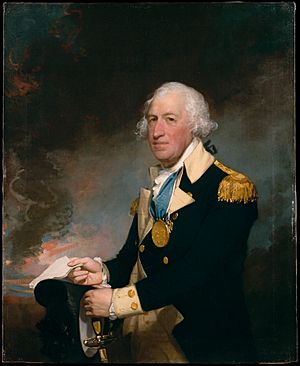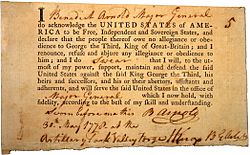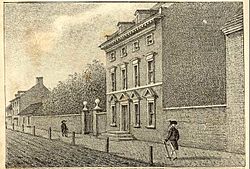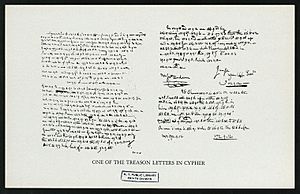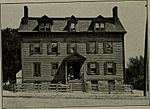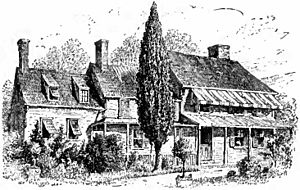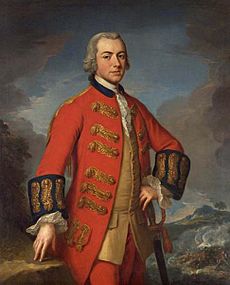Benedict Arnold facts for kids
Quick facts for kids
Benedict Arnold V
|
|
|---|---|
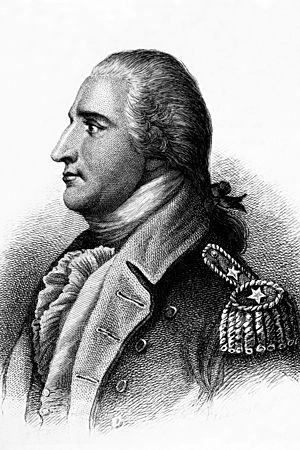
Benedict Arnold
Engraving by H.B. Hall after John Trumbull |
|
| Place of burial | |
| Service/ |
Colonial militia Continental Army British Army |
| Years of service | Colonial militia: 1757, 1775 Continental Army: 1775–1780 British Army: 1780–1781 |
| Rank | Major General (Continental Army) Brigadier General (British Army) |
| Commands held | Fort Ticonderoga (June 1775) Quebec City (siege, January–April 1776) Montreal (April–June 1776) Lake Champlain fleet (August–October 1776) Philadelphia (June 1778–April 1780) West Point (August–September 1780) American Legion (a Loyalist regiment, September 1780–1781) |
| Battles/wars | American Revolutionary War |
| Awards | Boot Monument |
| Signature | |
Benedict Arnold V (January 14, 1741 – June 14, 1801) was a general during the American Revolutionary War. He started the war fighting for the American Continental Army. However, he later switched sides and joined the British Army.
While serving America, he became the commander of West Point fort. He secretly planned to give control of West Point to the British. When his plan was discovered in September 1780, he became a brigadier general in the British Army.
Born in Connecticut, Arnold was a merchant who owned ships. When the war began in 1775, he joined the American army near Boston. He quickly became known for being smart and brave. His important actions included:
- Capturing Fort Ticonderoga in 1775.
- Using clever tactics after losing the Battle of Valcour Island in 1776.
- Fighting in the Battle of Ridgefield, where he became a major general.
- Helping to end the Siege of Fort Stanwix.
- His role in the Battles of Saratoga in 1777. He was badly hurt in the leg, which stopped him from fighting for several years.
The Continental Congress did not promote Arnold when he felt he deserved it. Other officers sometimes took credit for his achievements.
Feeling angry and unfairly treated, Arnold decided to switch sides in 1779. He began secret talks with the British. In July 1780, he asked for command of West Point. His goal was to surrender it to the British. Arnold's plan was revealed when American soldiers captured British Major John André. André was carrying papers that showed the plot. When Arnold learned of André's capture, he quickly escaped down the Hudson River. He boarded the British ship HMS Vulture. He almost got caught by George Washington's forces, who had been warned about the plot.
Arnold received a new rank as a brigadier general in the British Army. He also got an annual payment of £360 and a large sum of over £6,000.
He led British attacks in Virginia and against New London and Groton, Connecticut. The war effectively ended for the Americans with their victory at Yorktown.
In 1782, Arnold moved to London with his second wife, Margaret "Peggy" Shippen Arnold. King George III and the Tories welcomed him. However, the Whigs did not approve of him.
In 1787, he started a trading business with his sons in Saint John, New Brunswick. He returned to London permanently in 1791. He died there ten years later.
Because he changed sides, Benedict Arnold's name became a symbol for treason or betrayal in the United States.
Contents
Early Life and Business Beginnings
Benedict Arnold was born in Norwich, Connecticut, on January 14, 1741. He was the second of six children. He was named after his great-grandfather, Benedict Arnold, who was an early governor of Rhode Island.
When he was ten, Arnold went to a private school. He hoped to attend Yale, but his family could not afford it. He became an apprentice at a successful pharmacy and general store in Norwich. His apprenticeship lasted for seven years.
In 1757, at age sixteen, he joined the militia. They marched towards Albany and Lake George. The French had attacked Fort William Henry. Arnold served for 13 days before his company turned back.
Arnold's mother, whom he was very close to, died in 1759. After her death, Benedict took on the responsibility of supporting his father and younger sister. His father died in 1761.
Becoming a Businessman
With help from his former employers, Arnold opened his own pharmacy and bookstore in New Haven, Connecticut in 1762.
In 1764, he partnered with Adam Babcock, another young merchant. They used money from selling his home to buy three trading ships. They began trading with the West Indies.
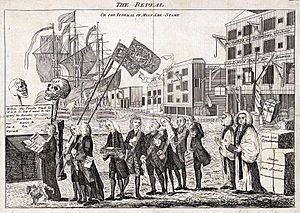
New laws like the Sugar Act of 1764 and the Stamp Act of 1765 made trade harder for the colonies. This led Arnold to join the Sons of Liberty. This was a secret group that sometimes used force to oppose unpopular British laws. Arnold continued to trade, ignoring the Stamp Act. This meant he was a smuggler.
On February 22, 1767, he married Margaret Mansfield. Their first son, Benedict VI, was born the next year. They later had two more sons, Richard and Henry.
Margaret died early in the Revolution, on June 19, 1775. Arnold was at Fort Ticonderoga at the time.
Early Days of the Revolutionary War
Arnold started his war service in March 1775. He was elected as a captain in Connecticut's militia. After the fighting at Lexington and Concord began, his company marched to help with the siege of Boston.
Arnold told the Massachusetts Committee of Safety about his idea to capture Fort Ticonderoga in New York. He knew it was not well defended. They made him a colonel on May 3, 1775. He rode west and joined Ethan Allen and his men to capture of Fort Ticonderoga.
He then led a daring attack on Fort Saint-Jean in Quebec. In June, he had a disagreement with another commander over control of Fort Ticonderoga. He resigned his Massachusetts commission. He was on his way home when he learned his wife had died.
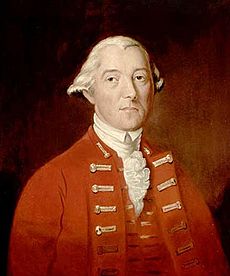
The Second Continental Congress planned an invasion of Quebec. Arnold had pushed for this, but he was not chosen to lead it.
Arnold then went to Cambridge, Massachusetts. He suggested to George Washington a second expedition to attack Quebec City. This would be through a wilderness route in present-day Maine. This expedition began in September 1775 with 1,100 men. Arnold received a colonel's commission for it. After a very difficult journey, Arnold reached Quebec City in November. He joined Richard Montgomery's small army. They attacked Quebec City on December 31. Montgomery was killed, and Arnold's leg was badly injured. Arnold was promoted to brigadier general for reaching Quebec. He kept up a weak siege of the city until April 1776.
Arnold then went to Montreal. He was the military commander there until the British army forced him to retreat. He commanded the rear of the Continental Army during its retreat. James Wilkinson said Arnold was the last person to leave before the British arrived.
He then oversaw the building of a fleet to defend Lake Champlain. This fleet was defeated in the October 1776 Battle of Valcour Island. His actions at Saint-Jean and Valcour Island helped delay the British advance until 1777.
During these events, Arnold made many friends and even more enemies within the army and Congress.
Battles and Frustrations
General Washington sent Arnold to defend Rhode Island. The British had taken Newport in December 1776. The local militia was not ready to attack the British.
Arnold was near his home, so he visited his children.
In February 1777, he learned that Congress had passed him over for promotion to major general. Washington refused Arnold's offer to resign. Washington wrote to Congress, trying to fix the issue. He warned that other good officers might leave if promotions were based on politics.
Arnold was on his way to Philadelphia to discuss his future. He then learned that a British force was marching towards a supply depot in Danbury, Connecticut. He helped organize the militia response. In the Battle of Ridgefield, he led a small group trying to stop the British. He was wounded in his left leg again.
Arnold continued to Philadelphia to talk about his rank. His actions at Ridgefield led to his promotion to major general. However, he was still ranked below officers who had been promoted before him. Arnold wrote a letter of resignation on July 11. On the same day, news arrived that Fort Ticonderoga had fallen to the British. Washington refused his resignation and ordered him north to help with the defense.
Arnold arrived at Fort Edward, New York on July 24. On August 13, he was sent with 900 men to help with the siege of Fort Stanwix. He used a trick to end the siege. Arnold sent a Native American messenger into the British camp. The messenger said that a much larger American force was coming. This made the British allies leave, forcing the British to give up.
Arnold then returned to the Hudson River. General Gates had taken command of the American army there. Arnold fought bravely in both Battles of Saratoga. However, General Gates removed him from field command after the first battle. This was due to many disagreements.
During the second battle, Arnold ignored Gates' orders. He went onto the battlefield and led attacks on the British. He was severely wounded in his left leg again. Arnold himself said he wished the injury had been to his chest instead of his leg.
Burgoyne surrendered ten days after the second battle, on October 17, 1777. Congress restored Arnold's command seniority because of his bravery at Saratoga. However, Arnold felt they did it out of sympathy for his wounds, not as an apology.
Arnold spent several months recovering from his injuries. His left leg was badly broken. It was set roughly, making it two inches shorter than his right leg. He returned to the army at Valley Forge in May 1778. The soldiers who had served under him at Saratoga cheered for him. There, he took part in the first recorded Oath of Allegiance. This was a sign of loyalty to the United States.
Arnold made the Masters-Penn mansion his headquarters. This was when he was military commander of Philadelphia. It later became the presidential mansion for George Washington and John Adams.
After the British left Philadelphia in June 1778, Washington made Arnold the military commander of the city.
Arnold began planning to make money from the change in power in Philadelphia. He made business deals to profit from war supplies. He used his authority to help these deals.
Arnold lived a very fancy life in Philadelphia. In the summer of 1778, Arnold met Peggy Shippen. She was 18 years old. Her father, Judge Edward Shippen, was a Loyalist supporter. Peggy had been courted by British Major John André when the British occupied Philadelphia. Peggy and Arnold married on April 8, 1779. Peggy and her friends found ways to stay in contact with the British. This was despite military rules against communicating with the enemy.
The Plot to Change Sides
In early May 1779, Arnold met with a man named Stansbury. Stansbury later said he went to New York to offer Arnold's help to Sir Henry Clinton. Stansbury ignored Arnold's instructions not to involve anyone else. He crossed British lines and met Jonathan Odell in New York. Odell was a Loyalist working with William Franklin. On May 9, Franklin introduced Stansbury to Major André. André had just become the British spy chief.
This was the start of secret letters between Arnold and André. Sometimes, Arnold's wife Peggy helped pass messages.
Secret Messages and Plans
André spoke to General Clinton, who gave him permission to follow up on Arnold's offer. André then wrote instructions for Stansbury and Arnold.
This first letter discussed what help and information Arnold could give. It also explained how to communicate in the future. Letters would be passed through Peggy Arnold's group of friends. Only Peggy knew that some letters contained instructions written in code and invisible ink. These were meant for André, with Stansbury as the messenger.
By July 1779, Arnold was giving the British information. This included troop locations and strengths, and supply depot locations. All the while, he discussed how much money he should get. He first asked for £10,000. By October 1779, the talks had stopped. Also, American mobs were looking for Loyalists in Philadelphia. Arnold and the Shippen family were being threatened. Arnold's requests for protection were turned down by Congress and local leaders.
Court-Martial and Rebuke
A military court began to hear charges against Arnold on June 1, 1779. It was delayed until December 1779. Arnold was cleared of all but two small charges on January 26, 1780. Arnold tried to make this public. However, in early April, Washington published a formal criticism of Arnold's actions. This was just one week after Washington congratulated Arnold on the birth of his son, Edward Shippen Arnold.
The Commander-in-Chief would have been much happier in an occasion of bestowing commendations on an officer who had rendered such distinguished services to his country as Major General Arnold; but in the present case, a sense of duty and a regard to candor oblige him to declare that he considers his conduct [in the convicted actions] as imprudent and improper.
– Notice published by George Washington, April 6, 1780
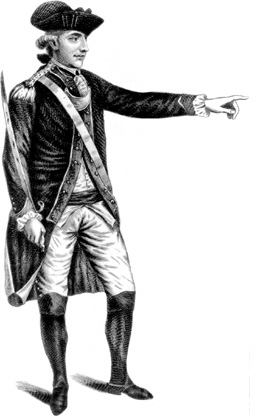
Soon after Washington's criticism, Congress looked into Arnold's spending. They found that Arnold had not fully accounted for money spent during the Quebec invasion. He owed Congress about £1,000. Many documents were lost during the retreat from Quebec. Angry and frustrated, Arnold resigned his military command of Philadelphia in late April.
Offering West Point to the British
In early April, Philip Schuyler suggested Arnold might command West Point. Arnold reopened his secret talks with the British. He told them about Schuyler's idea and Schuyler's thoughts on West Point. He also gave information about a planned French-American invasion of Quebec. (Arnold did not know this invasion was a trick to distract the British.)
On June 16, Arnold inspected West Point. He was on his way home to Connecticut for personal business. He sent a very detailed report through his secret contact. In Connecticut, Arnold arranged to sell his home. He began moving money to London through people in New York. By early July, he was back in Philadelphia. On July 7, he wrote another secret message to Clinton. He hinted that his appointment to West Point was certain. He also suggested he might provide a "drawing of the works... by which you might take [West Point] without loss."
General Clinton and Major André were very interested. Clinton was worried that Washington's army and the French fleet would join in Rhode Island. He again focused on West Point as a key place to capture. André, who had spies watching Arnold, confirmed his movements. Clinton was excited and told his superiors about his intelligence. However, he did not reply to Arnold's July 7 letter.
In a letter on July 11, Arnold complained that the British did not seem to trust him. He threatened to stop talking unless progress was made. On July 12, he wrote again. He clearly offered to surrender West Point. His price rose to £20,000, plus £1,000 upfront. These letters were delivered by Samuel Wallis, another Philadelphia businessman who spied for the British.
Commanding West Point
On August 3, 1780, Arnold became commander of West Point. On August 15, he received a coded letter from André. It contained Clinton's final offer: £20,000, but no payment for Arnold's losses. Because messages were hard to get across the lines, neither side knew for days that the other agreed. Arnold's letters continued to detail Washington's troop movements. He also gave information about French reinforcements. On August 25, Peggy finally gave him Clinton's agreement.
Washington gave Arnold command of West Point. He also gave him authority over the entire American-controlled Hudson River. This stretched from Albany down to the British lines near New York City. On his way to West Point, Arnold met Joshua Hett Smith again. Smith had spied for both sides. He owned a house near the Hudson River, south of West Point.
Once at West Point, Arnold began to weaken its defenses. Necessary repairs on the chain across the Hudson were never ordered. Troops were spread out in Arnold's command area, but few were at West Point itself. He also complained to Washington about a lack of supplies. At the same time, he tried to drain West Point's supplies. This would make it easier for the British to capture. His officers, some of whom had known him for a long time, complained. They thought Arnold was selling supplies illegally for his own gain.
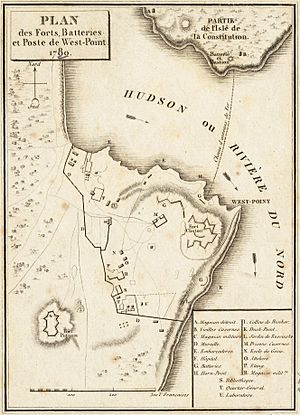
On August 30, Arnold sent a letter accepting Clinton's terms. He suggested a meeting with André. He sent it through William Heron, a member of the Connecticut Assembly he thought he could trust. Heron went to New York without knowing the letter's importance. He offered his own services to the British as a spy. He then took the letter back to Connecticut. Suspicious of Arnold, he gave it to the head of the Connecticut militia.
General Parsons saw the letter. It looked like a coded business discussion, so he put it aside. Four days later, Arnold sent another coded letter to New York. He used a prisoner-of-war's wife to deliver it. Eventually, a meeting was set for September 11 near Dobb's Ferry. This meeting failed when British gunboats fired on Arnold's boat. They had not been told of his arrival.
The Plot is Discovered
Arnold and André finally met on September 21 at Joshua Hett Smith's house. On the morning of September 22, James Livingston fired on HMS Vulture. This was the ship meant to take André back to New York. The ship was damaged and had to retreat. This forced André to return to New York by land. Arnold wrote passes for André so he could get through the lines. He also gave André plans for West Point.
On Saturday, September 23, André was captured near Tarrytown. Three patriots named John Paulding, Isaac Van Wart, and David Williams caught him. The papers showing the plot to capture West Point were found. They were sent to Washington. Arnold's betrayal became clear after Washington examined them.
Arnold learned of André's capture the next morning, September 24. He received a message that André was captured and the papers were sent to Washington. Arnold got the letter while waiting for Washington, with whom he had planned to have breakfast. He quickly went to the shore. He ordered boatmen to row him downriver to the Vulture. The ship then took him to New York.
From the ship, Arnold wrote a letter to Washington. He asked that Peggy be given safe passage to her family in Philadelphia. Washington granted this request.
When shown proof of Arnold's betrayal, Washington was reportedly calm. He investigated how widespread the betrayal was. He suggested to General Clinton that he would exchange André for Arnold. Clinton refused this. After a military trial, André was hanged on October 2. Washington also sent men into New York to try to kidnap Arnold. This plan almost worked but failed when Arnold changed where he lived.
Arnold tried to explain his actions in an open letter. It was called To the Inhabitants of America. It was published in newspapers in October 1780. In his letter to Washington, he wrote that "Love to my country actuates my present conduct." He added that the world often judges people's actions wrongly.
After Switching Sides
The British made Arnold a brigadier general. He received an annual income of several hundred pounds. However, he was only paid £6,315 plus an annual pension of £360 because his plot failed.
In December 1780, Arnold led 1,600 troops into Virginia. He captured Richmond by surprise. He then destroyed supply houses, foundries, and mills across Virginia. This brought out Virginia's militia. Arnold eventually retreated to Portsmouth to be evacuated or reinforced. The American army pursuing him included the Marquis de Lafayette. Lafayette was ordered by Washington to hang Arnold if he was captured.
Reinforcements arrived in late March. They were led by William Phillips. Phillips led more raids across Virginia. He defeated Baron von Steuben at Petersburg. Phillips died of fever on May 12, 1781.
Arnold commanded the army until May 20. Then Lord Cornwallis arrived and took over. Cornwallis ignored Arnold's advice to find a permanent base away from the coast. This might have prevented his later surrender at Yorktown.
Arnold returned to New York in June. He suggested many ideas for attacking American economic targets. He hoped this would force the Americans to end the war. Clinton was not interested in most of Arnold's ideas. But he finally allowed Arnold to raid the port of New London, Connecticut.
On September 4, Arnold's force of over 1,700 men raided and burned New London. They also captured Fort Griswold. This caused about $500,000 in damage. British casualties were high. Nearly a quarter of their force was killed or wounded. Clinton said he could not afford such losses.
Before Cornwallis surrendered in October, Arnold asked Clinton for permission to go to England. He wanted to share his thoughts on the war with Lord Germain. When news of the surrender reached New York, Arnold asked again. Clinton then granted his request.
On December 8, 1781, Arnold and his family left New York for England. In London, he joined the Tories. He advised Germain and King George III to continue fighting the Americans. In the House of Commons, Edmund Burke hoped the government would not put Arnold "at the head of a part of a British army." He felt it would harm the honor of British officers.
Arnold then tried to join General Carleton, who was going to New York. This request was denied. Other attempts to get government jobs or positions in the British East India Company failed. He had to live on the lower pay of non-wartime service.
His reputation also suffered in the British press. Major André was praised for his patriotism, while Arnold was criticized.
New Business Ventures
In 1785, Arnold and his son Richard moved to Saint John, New Brunswick. They bought land and started a trading business with the West Indies.
Arnold bought large areas of land and city lots in Saint John and Fredericton.
Arnold returned to London in 1786 to bring his family to Saint John. The family moved to Saint John in 1787. There, Arnold caused trouble with bad business deals and small lawsuits. After winning a lawsuit against a former business partner, townspeople burned an effigy of him in front of his house. Peggy and the children watched. The family left Saint John and returned to London in December 1791.
In July 1792, he fought a duel with the James Maitland, 8th Earl of Lauderdale. No one was hurt. The Earl had questioned Arnold's honor.
When the French Revolution began, Arnold prepared a privateer ship. He continued trading in the West Indies, even though the fighting made it risky.
French authorities arrested him on Guadeloupe. They accused him of spying for the British. He narrowly escaped hanging by bribing his guards. He fled to the British fleet that was blocking the port.
He helped organize militia forces on British-held islands. Landowners praised him for his efforts. This work, which he hoped would earn him respect and a new command, instead earned him and his sons a land grant of 15,000 acres in Upper Canada. This land was near present-day Renfrew, Ontario.
Later Life and Death
In January 1801, Arnold's health began to worsen. He died after four days of confusion, on June 14, 1801, at age 60.
Arnold was buried at St. Mary's Church, Battersea in London, England. His funeral procession was large, but it had no military honors.
He left a small estate, reduced by his debts. Peggy cleared these debts by selling household items. He left gifts to a man named John Sage, who was later found to be his son.
Family Life
During his marriage to Margaret Mansfield, Arnold had these children:
- Benedict Arnold VI (1768–1795) (a captain in the British Army, killed in action)
- Richard Arnold (1769–1847)
- Henry Arnold (1772–1826)
With Peggy Shippen, he had a family active in British military service:
- Edward Shippen Arnold (1780–1813) (a lieutenant)
- James Robertson Arnold (1781–1854) (a lieutenant general)
- George Arnold (1787–1828) (a lieutenant colonel)
- Sophia Matilda Arnold (1785–1828)
- William Fitch Arnold (1794–1846) (a captain)
Arnold's will included gifts to John Sage (born 1786). Some historians believe Sage might have been an illegitimate son or grandson.
Honors and Legacy
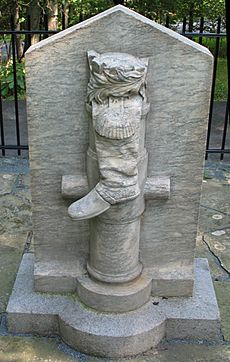
At the Saratoga battlefield, now Saratoga National Historical Park, there is a monument for Arnold. However, his name is not on it. The Boot Monument was given by Civil War General John Watts DePeyster. The inscription reads: "In memory of the most brilliant soldier of the Continental army, who was desperately wounded on this spot, winning for his countrymen the decisive battle of the American Revolution, and for himself the rank of Major General." The victory monument at Saratoga has four spaces for statues. Three are filled with Generals Gates, Schuyler, and Morgan. The fourth space is empty.
On the grounds of the United States Military Academy at West Point, there are plaques for all generals who served in the Revolution. One plaque only says "major general" and "born 1740," with no name.
The house at 62 Gloucester Place where Arnold lived in central London still stands. It has a plaque that calls Arnold an "American Patriot." St. Mary's Church, Battersea, England, where Arnold was buried, has a stained-glass window added between 1976 and 1982 to remember him. The faculty club at the University of New Brunswick, Fredericton, has a Benedict Arnold Room. Original letters written by Arnold hang on the walls there.
Interesting Facts About Benedict Arnold
- He is known as the most famous traitor in US history.
- In the United States, calling someone a "Benedict Arnold" means you are calling them a traitor.
- Benedict Arnold's second wife, Peggy Shippen, helped him with his secret plans. She was one of the highest-paid spies in the American Revolution.
- At the start of the Revolution, he was considered a hero.
Images for kids
-
An 1865 political cartoon showing Benedict Arnold and Jefferson Davis in hell
See also
 In Spanish: Benedict Arnold para niños
In Spanish: Benedict Arnold para niños


